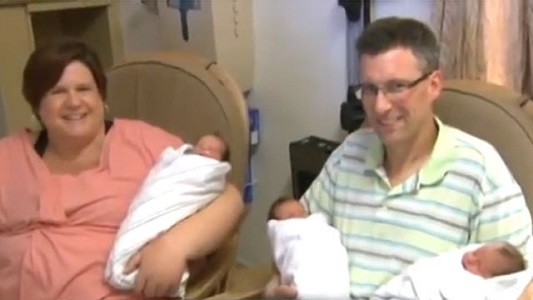A California family doubled in size very quickly when April Dolly and her husband, who also have a daughter, gave birth to triplets on January 13. The triplet boys were conceived without the aid of fertility treatments and are identical. Dr. William Gilbert, an expert in women’s health, estimated that the likelihood of this event occurring sans medical intervention (from fertility treatments) can range from 1 in 70,000 to 1 in one million.
The boys, Patrick, Owen, and Liam, were all born healthy with the exception of one little boy needing intestinal surgery. However, all three babies are doing well. As is normal for multiples, the boys entered the world weeks earlier than the standard 40-week gestation common to singletons.
 April, who is 42 years old, describes the combination of shock and excitement she and her husband experienced when they first found out they were going to welcome three children into the world at once:
April, who is 42 years old, describes the combination of shock and excitement she and her husband experienced when they first found out they were going to welcome three children into the world at once:
We were very shocked when we found out we were having three babies because we did nothing to have more than one and multiples don’t run in our family. Once we got over the shock, we’ve just been really excited and anticipating this day.
While April’s story is inspiring and beautiful, not all moms have the same joyful reaction at the news of multiples. Some women in April’s position are now opting for “pregnancy reduction” when they discover they are carrying more than one child. This phenomenon, in which multiple babies are “reduced” to one or two by aborting the others, is easily seen as just another medical decision among women who achieve pregnancy via fertility treatments.
Several years ago, the New York Times addressed the issue of multiple-child pregnancies for women who are in the latter part of their childbearing years, like April, and how pregnancy reduction is sometimes viewed among this group. One woman who chose to reduce her twins to a singleton by hiring a doctor to kill one of them recalls her experience with “pregnancy reduction”:
Things would have been different if we were 15 years younger or if we hadn’t had children already or if we were more financially secure. If I had conceived these twins naturally, I wouldn’t have reduced this pregnancy, because you feel like if there’s a natural order, then you don’t want to disturb it. But we created this child in such an artificial manner — in a test tube, choosing an egg donor, having the embryo placed in me — and somehow, making a decision about how many to carry seemed to be just another choice. The pregnancy was all so consumerish to begin with, and this became yet another thing we could control.
CLICK LIKE IF YOU’RE PRO-LIFE!
Unfortunately, essentially all women go into in vitro fertilization procedures having created more than one child (externally, in a Petri dish). These children are then implanted in the hopes that at least one will “take,” while those who cannot thrive in the environment into which they are placed will simply die and disappear. It is no wonder that, assenting to the loss of countless children as a commonplace and expected outcome of the in vitro process, women and doctors have also grown comfortable with the idea of choosing to reduce the number of those children who succeeded in the unlikely journey of artificially-created life.







